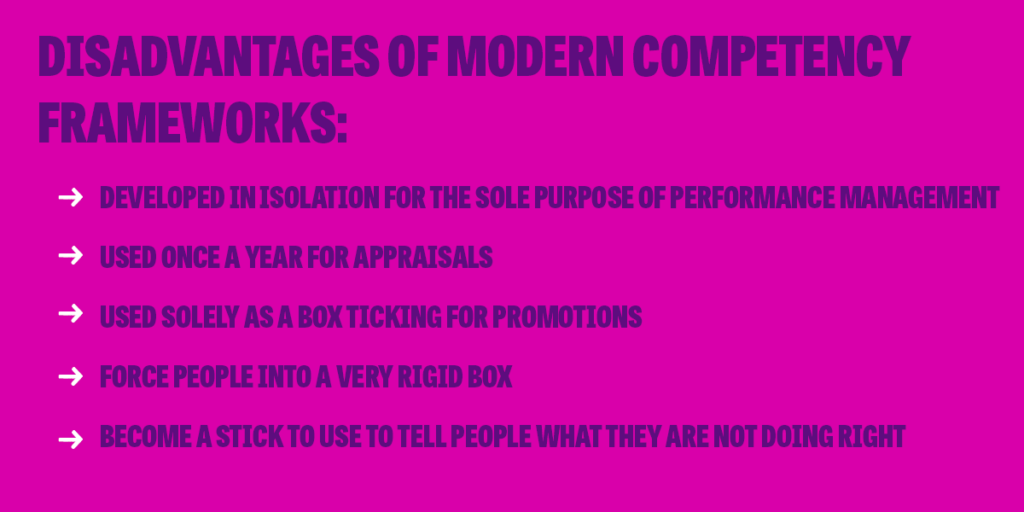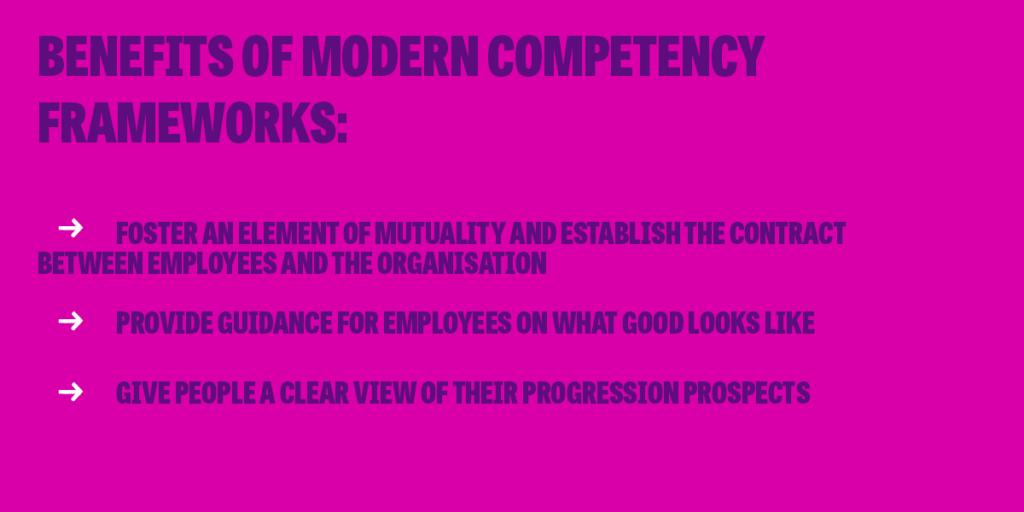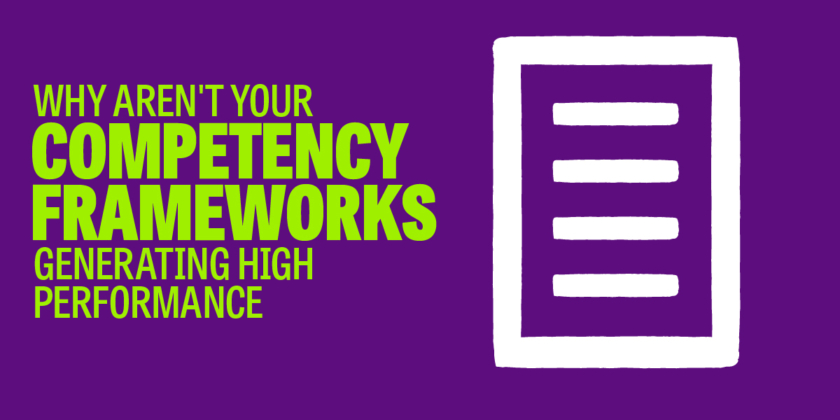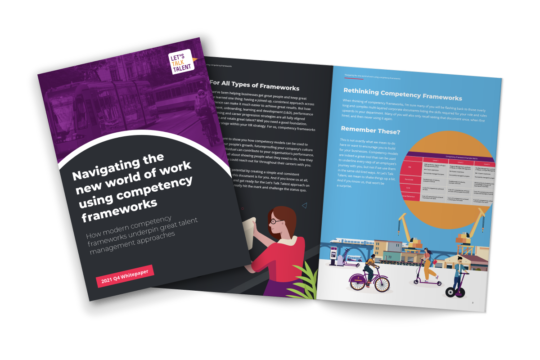Reassessing competency frameworks for the modern workforce
Many of us have lost faith in competency frameworks over the past few years. In a new organic, hybrid world of work where innovation, diversity and more importantly, agility, are key to winning the war on talent, where do these strict grids fit in? Are competency frameworks still relevant today and if so, why do they never seem to be used past the initial onboarding phase, or at least on a more regular basis as a way to help people navigate their careers?
At Let’s Talk Talent, we believe that whilst competency frameworks may be slightly misunderstood, HR departments and businesses everywhere should give them a fighting chance. Because when used right, they can indeed become the lynchpin that holds together your entire employee experience. So why are they often not helping businesses achieve the kind of high performance they were hoping for in the first place? Why are today’s competency frameworks failing?
We have a long history of helping clients create effective, dynamic competency frameworks. And we know what it takes to turn a complex, multi-tiered document full of beige corporate jargon (read our common HR definitions) into the kind of colourful super tool that generates results. Here is our take on how to avoid the most common pitfalls when designing your competency frameworks.
In this article, you will learn:
Why competency frameworks are failing
In short, the most common reason for competency frameworks not being as effective as hoped is a simple one. They are, more often than not, developed in isolation, as a stand-alone tactic used solely for performance management. Many sectors, such as professional services, whip them out once a year to support their year-end appraisal process or as a way to determine if a key member of staff should be promoted, or given a financial reward. In short, they become a stick to use when trying to get more out of staff, whilst businesses often forget about the carrot.

If you find yourself using competency frameworks to tell people what they are not doing right, ask yourself: are you putting the psychological contract to the individual’s disadvantage, and if so, how could you use competency frameworks to foster an element of mutuality? Because using competency frameworks shouldn’t be about managers holding all the power. Both parties should feel they are working towards a common goal, whilst getting something out of the business at the same time. When that balance is reached, employee retention and motivation follow suit. Competency frameworks should therefore be more of a guide rail than a stick to beat people with.
But if most models and grids are too strict and force people to fit inside a very defined box, should we get rid of them altogether and give people the freedom to determine how to do their job and develop their own careers?
For more information on how to use competency frameworks for career development, have a read of the article.
Well, balance is key, and letting creative chaos reign is no better than holding on to an old-fashioned industrial mindset. Putting some support in place is, of course, required to avoid choice paralysis and ensure people have a clear view of the career progression options available to them. Looking at a thousand possible ways to climb up the mountain can prove just as stifling as only having one unsuitable option. Guidance and support from both managers and the organisation itself have their raison d’être, so long as they don’t prevent creativity, curiosity or autonomy when it comes to people taking charge of their professional development. There are so many opportunities for development: competency frameworks should help staff narrow their gaze.
But honestly, can competency frameworks really do all of the above?
Indeed they can. Here’s how you should be using them.

How to design competency frameworks that work
Competency frameworks are in place to help staff answer three main questions:
- What do I need to do to be successful within the organisation?
- How do I need to do it?
- How can I navigate my career?
In short, they are the guide rails helping you create the kind of culture that celebrates its people’s creativity and diversity. They enable your employees to develop the confidence they need to just go ahead and take charge of their careers, whilst also striving to make a meaningful contribution to the business.
In order to do this, competency frameworks need to be all-encompassing. They should be used, not as a stand-alone tool for performance management, but as the foundation upon which to build every single one of your HR pillars, from recruitment to talent management. The skills, attributes, training and relationships (STAR) needed to do the job well, achieve a high level of performance and progress to the next level should be clearly displayed and available for all to see.
As an example, successful organisations use their competency frameworks to create tailored job postings, interview questions and assessment centres. They design career pathways for each role, and ensure related learning and development opportunities are made available to support employees. They use career frameworks to identify high potential candidates and plan ways to develop their skills and attributes in order to future-proof the business. They identify skills gaps within their talent pool and find ways to fill them. They also use frameworks for performance management, of course. But not so much as a stick: more as a basis upon which to structure career conversations and give regular developmental feedback that will help their people unlock their full potential.
Expanding beyond performance management is the only way to generate high performance within the organisation, and competency frameworks are the only tool that can be used to underpin the entire employee experience. So how do you develop frameworks that will help staff navigate their career, from the first time they hear about you to the day they leave? A couple of quick tips:
- Once designed and rolled out, competency frameworks shouldn’t stay in a drawer. Check regularly that they still work well, and are interlinked with the rest of your HR and business strategy. Stress test them with the community around you to validate that they truly give your people what they were meant to bring them: clarity.
- Start small, then build up. You don’t have to develop all your competency frameworks at once. Create a small pilot group and, once you’ve got a formula that works and truly empowers your people, move to the next group.
Generating purpose using competency frameworks
Designing competency frameworks that generate both job satisfaction and high performance is all about balance. Balance of power. The stick, with the carrot. It’s about driving employees’ purpose, without stifling it, and giving people a choice when it comes to navigating their career with you. By creating tools solely focused on performance management and end-of-year ratings, organisations are depriving themselves of the opportunity to go much further and foster motivation, innovation, creativity and ultimately, high performance.
Avoid these 10 common performance management mistakes
So if you’d like to discuss how LTT can help you design competency frameworks that deliver high performance, book a call with us. Or download the competency frameworks whitepaper on our competency framework service page for more information.
Related competency frameworks resources:
- Find out more about our competency frameworks consultancy [Service]
- Download our free modern competency framework whitepaper [Free Whitepaper]
- Competency framework examples: which ones should you trust? [Blog post]
- Re-imagining competency frameworks for the modern workforce [Blog post]
- How to develop effective competency frameworks [Blog post]
- The EDGE feedback framework for effective development conversations [Blog post]
- How to use competency frameworks to help career development [Blog post]

